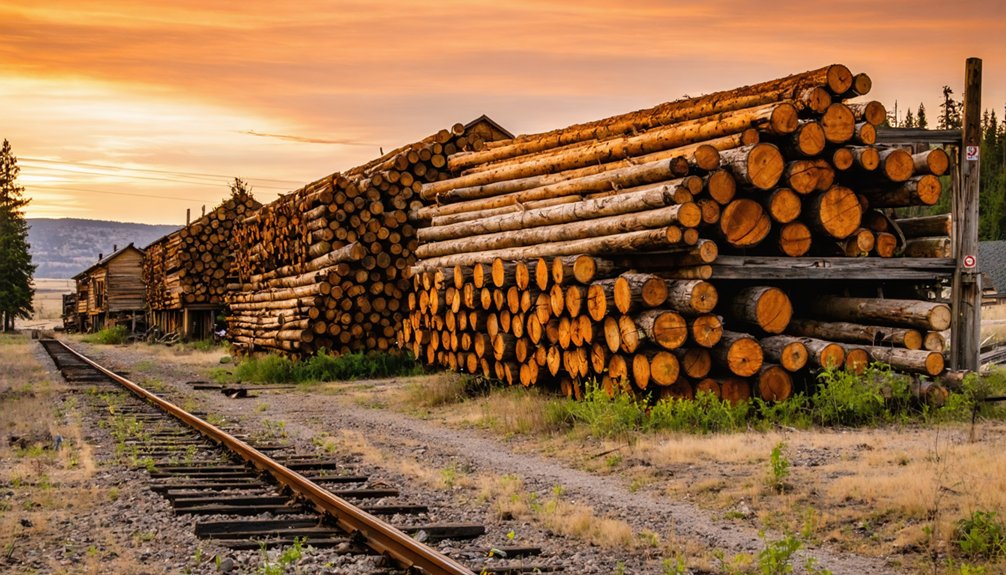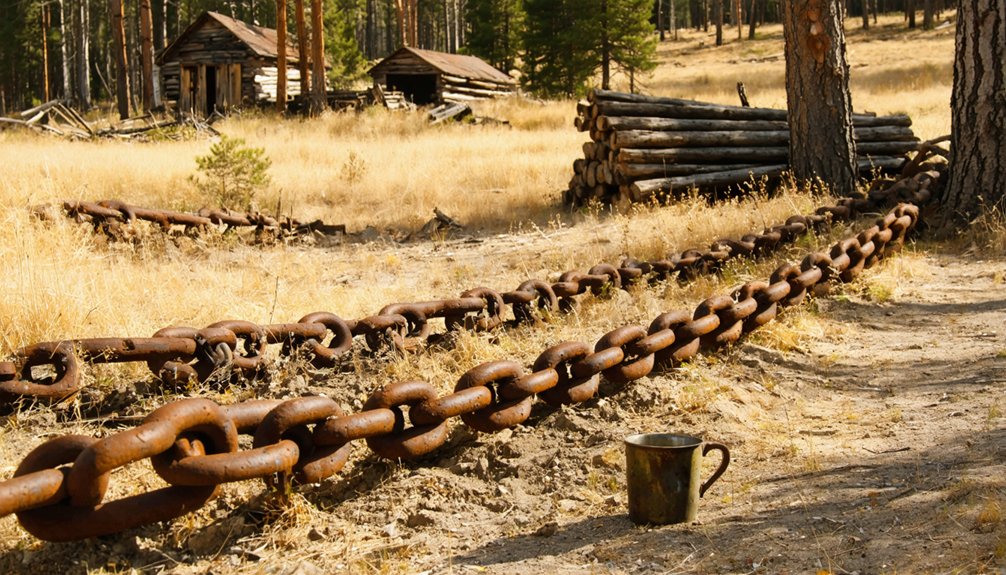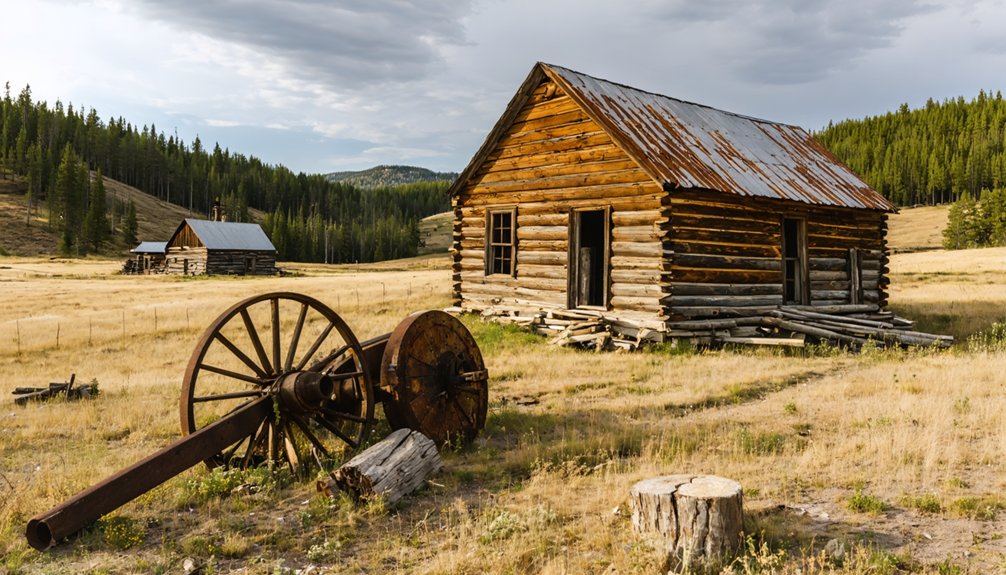You’ll find String Town‘s origins in South Dakota’s early 1900s logging boom, where worker shacks lined up like a string along Jim Creek’s railroad tracks. The bustling camp featured simple timber cabins, a sawmill, and a close-knit community of loggers who shared meals in the cookhouse and enjoyed evening entertainment in the bunkhouses. After timber resources dwindled around 1910 and the Great Depression hit, the once-thriving settlement gradually faded into the Black Hills’ rich historical landscape.
Key Takeaways
- String Town originated as an early 1900s logging camp along Jim Creek in South Dakota, named for worker shacks aligned along railroad tracks.
- The camp featured simple timber shacks with dovetail corner notching, built for quick assembly and heated by wood-burning stoves.
- Daily life centered around dawn-to-dusk logging work, with locomotive whistles marking schedules and communal meals fostering community spirit.
- Workers lived in one-and-a-half story cabins with Scandinavian-style features, arranged closely along gravel pathways near the railroad.
- The town declined around 1910 due to depleted timber resources and was fully abandoned during the Great Depression.
The Rise of a Black Hills Logging Settlement
As the Black Hills logging industry expanded in the early 1900s, String Town emerged as a bustling camp along Jim Creek in South Dakota.
You’ll find its logging camp origins were closely tied to the railroad, which made it an ideal location for timber transport and processing. The settlement got its distinctive name from the way worker shacks lined up like a string on both sides of the tracks.
Worker cabins stretched along the railroad tracks like beads on a string, giving this Black Hills timber camp its memorable name.
In those early days, you’d have seen a growing community of loggers and their families settling into this transient community, drawn by the promise of steady work in the timber-rich forests. The workers’ homes were densely packed together, similar to the housing arrangements described in other logging settlements of the era. Like the nearby Homestake Mining Company operations, the camp established a sawmill for timber processing to support the region’s resource needs.
While the settlement’s infrastructure remained basic, String Town played an essential role in the region’s timber industry, connecting the natural resources of the Black Hills to broader markets through its strategic railway position.
Life Along the Railroad Line
You’d hear the locomotives’ whistles pierce through String Town’s morning air as workers emerged from their shared bunkhouses near the tracks.
Your daily routine would revolve around the railroad’s schedule, with meals and social gatherings timed to coincide with train arrivals that brought mail, supplies, and occasional visitors.
Walking along the rail line, you’d pass workers’ quarters and communal spaces where loggers swapped stories and shared news from distant family members after long days of timber work. Like many Black Hills communities that relied on declining railroad transport, String Town eventually faded as trucking became the preferred shipping method.
Daily Track-Side Routines
While the Railroad Depot served as String Town’s beating heart, the daily routines along its tracks kept the community’s pulse strong.
You’d see workers clearing debris and fixing rails during track maintenance, ensuring every train could pass safely through town. The eight hour journey between Nemo and Lead demonstrated the challenging terrain crews had to maintain. The precise freight scheduling kept goods flowing smoothly between loading zones and warehouses. Like its modern counterpart, the oldest continuously operating locomotive in the nation, these trains were vital to the region’s development.
At the sidings, you’d find crews coordinating the movement of timber, mining supplies, and agricultural products. Horse teams would skid massive logs from nearby camps to the railroad loading areas, where workers carefully staged them for transport.
Inside the depot, station agents managed the complex dance of incoming and outgoing trains, while telegraph operators kept essential communications flowing to distant points along the line.
Living quarters in String Town huddled tightly along the railroad tracks, creating the distinctive “string” pattern that gave the settlement its name.
You’d find simple timber shacks hastily constructed to house the transient workforce, offering basic shelter from Black Hills weather with little more than wood stoves for warmth and lanterns for light.
Without running water or indoor plumbing, you’d share outhouses and rely on natural water sources.
The close-knit arrangement of cabins fostered a practical community spirit where workers supported each other through harsh conditions.
You might’ve joined communal meals in the occasional mess hall or gathered for card games and storytelling during precious downtime.
Despite the rough conditions, these shared living spaces created bonds among workers who depended on each other for survival and companionship.
Architecture and Living Conditions
You’d find String Town’s simple shacks constructed from hewn logs with dovetail corner notching, featuring overlapping horizontal planks to seal gaps between logs for insulation against harsh Dakota winters.
The camp’s housing layout stretched along the railroad line, with structures built for quick assembly and disassembly as logging operations moved, while maintaining efficient access to work sites. The construction methods reflected techniques similar to those used by general contractor William Bartlett in his early Lead developments.
Inside these modest dwellings, you’d see multi-purpose spaces combining cooking, sleeping, and storage areas, typically heated by wood-burning stoves with stockpiled firewood nearby.
Simple Shack Construction Methods
Since logging camps required quick yet durable shelter, String Town’s workers developed efficient shack construction methods using locally sourced materials.
You’d start by selecting green pine or fir logs from nearby stands, as they’re easier to peel and shape with basic hand tools. After burning the ends for rot resistance, you’d lay a shallow foundation about 30 cm deep with stone and concrete. Builders would carefully notch the logs about one foot from each end to ensure stable corner placement.
Using log cabin techniques, you’d place larger logs at the bottom for structural support, then stack them using either saddle notching or the simpler butt-and-pass method. Builders would aim for logs with at least 15 cm diameter to ensure adequate structural integrity.
For rustic building materials, you’d weave hazel wattle panels for the roof, cover them with tarps, and add dry bracken for waterproofing. Inside, you’d finish with a basic concrete floor and use mud or moss chinking between logs for insulation.
Railroad-Adjacent Housing Layout
Most housing structures in String Town’s logging camp followed a distinctive pattern, positioned strategically alongside the Black Hills and Fort Pierre Railroad’s narrow-gauge tracks.
Simple railroad housing units formed tight rows parallel to the rails, maximizing efficiency while providing workers quick access to loading areas. You’ll find the loggers quarters were built on elevated platforms to prevent water damage from wooden tie beds. The builders used black chalk staining techniques to weather and protect the wooden structures. The camp’s location was crucial, as it supported the Homestake Mining Company with essential timber supplies.
- Raw timber walls echoed the rugged spirit of frontier life
- Windows faced the tracks, keeping you connected to the bustling rail activity
- Gravel pathways between homes reminded you of the temporary nature of camp life
- Narrow clearances between buildings spoke of a close-knit worker community
- Basic shelters represented the freedom of a simpler, untamed existence
The 3-foot narrow gauge allowed for closer spacing of buildings, creating an intimate camp layout that fostered community bonds despite harsh conditions.
Daily Living Space Design
While String Town’s railroad housing formed neat rows, the logging camp‘s individual living spaces showcased remarkable craftsmanship through their distinctive Scandinavian-influenced design.
You’d find each cabin built with carefully selected logs, joined together using dovetail corner notching without a single nail – a reflection of the log craftsmanship passed down through generations.
The one-and-a-half story structures blended seamlessly into the forest landscape, with horizontal logs adorning the gable ends in true Scandinavian style.
As time passed, community construction efforts added American touches like sunburst-patterned dormers. You’ll notice how these modifications maintained the natural, rustic character while adapting to local architectural preferences.
The cabins’ enduring strength came from both skilled construction techniques and the spirit of community maintenance that kept them standing.
The Timber Industry’s Golden Years

As the Black Hills region emerged as a timber powerhouse, South Dakota’s wood processing industry flourished with 23 active mills by 2009, including sawmills, particleboard facilities, and post and pole operations.
You’ll find that this logging history shaped the region’s timber economy, with the Black Hills producing 98% of the state’s saw log harvest during the industry’s peak years.
- You could witness massive ponderosa pine harvests transforming the landscape
- You’d see bustling logging camps springing up throughout the Black Hills
- You’d find sawmills running at full capacity, processing 26 million cubic feet of wood
- You’d experience the community pride in supplying 81% of the state’s timber needs
- You’d marvel at the regional cooperation as Wyoming contributed 16% of needed resources
Daily Life in a Logging Community
The daily rhythm of String Town‘s logging community centered around a bustling camp complex, where life unfolded in the shadow of towering ponderosa pines.
You’d start your day at dawn, grabbing your axes and saws before heading into the forest for backbreaking work until sundown.
The heart of camp life revolved around logging rituals and communal meals in the cookhouse, where you’d feast on hearty portions of beans, pork, and steak alongside your fellow lumberjacks.
After work, you’d return to the bunkhouse, where entertainment meant wrestling matches on bare floors or high-stakes poker games.
If you were lucky, your camp might’ve had modern amenities like running water, but most men endured spartan conditions.
Physical toughness wasn’t just expected – it was essential for survival in this demanding environment.
The Path to Abandonment and Legacy

Once bustling with the sounds of sawmills and railroad whistles, String Town’s decline began around 1910 as nearby timber resources dwindled and economic pressures mounted.
You can trace the community’s economic decline through the gradual departure of logging families and workers who’d called this Black Hills settlement home.
- Railroad lines that once connected String Town to prosperity fell silent as timber transport ceased
- The Great Depression dealt a devastating blow to lumber demand, accelerating the town’s abandonment
- Homes and buildings were dismantled or left to decay, erasing physical traces of the community
- Local families scattered to find work elsewhere, breaking bonds of community resilience
- The settlement’s memory lives on through historical records and oral histories
Today, String Town serves as a poignant reminder of how resource-dependent communities can vanish when economic foundations crumble.
Frequently Asked Questions
What Native American Tribes Originally Inhabited the Area Around String Town?
You’ll find that Lakota tribes, part of the greater Sioux Nation, originally dominated this area, sharing their tribal history across the Black Hills region through hunting, ceremonies, and spiritual practices.
Were There Any Major Accidents or Disasters Recorded at String Town?
While you’ll find records of regional storms and floods, there aren’t any documented major logging accidents or historical disasters specifically at String Town, though daily hazards likely plagued the remote camp’s operations.
How Many People Lived in String Town During Its Peak Population?
You won’t find exact String Town demographics in historical records, but based on similar logging camps and historical population trends, it likely housed between 50-100 people at its peak around 1900.
Did String Town Have a School or Church for the Community?
Want to know about community services in String Town? You’ll find they had a chapel for religious gatherings, which remains a famous landmark today, but there’s no evidence they ever established a school.
What Specific Types of Trees Were Predominantly Harvested Near String Town?
You’ll find that ponderosa pine was the lumber industry’s main target near String Town, where they’d harvest these towering trees reaching 80 feet high and living up to 250 years.
References
- https://explore.digitalsd.org/digital/api/collection/WRHC/id/307/download
- https://gsmit.org/if-fodderstack-could-speak-logging-days/
- https://www.sdpb.org/rural-life-and-history/2023-08-21/some-black-hills-ghost-towns-and-their-origins
- https://www.sdhspress.com/journal/south-dakota-history-2-2/some-black-hills-ghost-towns-and-their-origins/vol-02-no-2-some-black-hills-ghost-towns-and-their-origins.pdf
- https://history.sd.gov/preservation/docs/FederalReliefMPL.pdf
- https://en.wikipedia.org/wiki/List_of_ghost_towns_in_South_Dakota
- https://www.legendsofamerica.com/south-dakota-ghost-towns/
- https://www.southdakotamagazine.com/the-nemo-life
- https://history.sd.gov/preservation/docs/SDRailroad.pdf
- https://dot.ca.gov/-/media/dot-media/programs/environmental-analysis/documents/ser/work-camps-a11y.pdf



